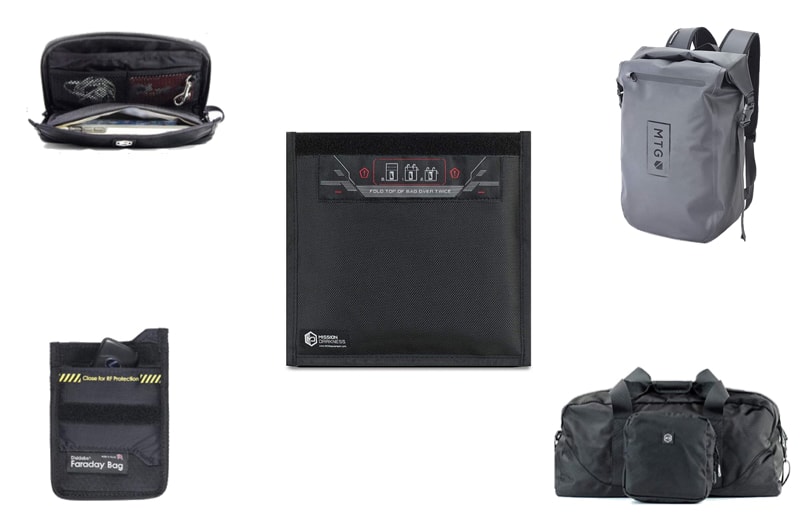You may not realize it but almost everywhere you go, you have RFID (Radio Frequency Identification) on you. It’s inside most credit cards and debit cards as well as newer key fobs.
If you’ve ever used tap to pay, you’ve used RFID technology. There’s a microchip and antenna inside your card, tag, and fob that sends your data (personal or financial information) to the antenna inside the merchant terminal or vehicle.
This technology is convenient and make our lives easier but is it really safe to use?
What is RFID Blocking?

Even though this technology makes transactions faster and easier, there are risks with using it. Your personal and financial information can be accessed by hackers.
Chips can be rewritten with a hacker’s information, you could lose money, etc.
This is why I recommend everyone use RFID signal blocking products like a Faraday bag, key fob pouch, or RFID-blocking wallet.
These bags use RFID-blocking material (like carbon fiber, silver, or aluminum) that disrupt the signal in your chip. This makes it impossible for thieves to connect to your chip keeping your personal and banking information safe.
Ways Your RFID Chip Can Be Hacked
Without a shielding cover, there are currently several ways your RFID chip can be accessed and stolen by thieves. As technology advances, so do the hackers.
1. Skimming

Skimming is when someone uses a reader to illegally get data from your RFID chip. This could be your banking information, personal information, or even the code to trick your vehicle into believing the key fob is next to your car.
You may be familiar with skimmers that are attached to debit machines or ATMs but there are now high-powered wireless skimmers and apps that can pick up data without touching your card.
This information is then used to clone credit cards or use your information to commit identity theft.
You wouldn’t even know that your information was stolen. It could be accessed through your purse or pocket on the train or waiting in line, someone passing by you at a cafe, etc.
2. Eavesdropping
Eavesdropping is when a thief intercepts data from your chip that is being sent from your tag or card to an authorized RFID reader.
This could occur in the middle of a tap payment at a store or gas station, when using your gate card at your parking facility, or scanning your passport at Customs.
A hacker can eavesdrop from a further distance than skimming, but timing has to be exact to intercept the communication. However, they can set up their scam near devices they know will be receiving contact-less payments to have many chances at intercepting signals.
Unfortunately these RFID receiver kits are inexpensive and easy to get or make so it doesn’t take skill to carry out.
3. Tracking

When you use chipped devices like the E-Z pass or other toll passes, cards for parking garages, etc. you inadvertently leave a trail of location data. The two data points can also track your average speed.
New York state has begun tracking the movement of vehicles to estimate traffic patterns and travel times.
Tracking tags and stickers are used on luggage, pets, and other belongings to track their location, some with real time location systems which give a location within 10 feet.
Although this is handy and convenient, a stalker or the government can also use this technology to monitor your activities and track your location.
4. Car Theft

Car thieves are now using RFID readers to trick your vehicle into thinking that your key fob is close to your vehicle, even though it might be in your pocket in your office or in your home while you sleep.
This is more commonly used to break into vehicles but can also be used to steal them. Thieves duplicate the communication signal from your key fob and gain access to your car without setting off any alarms. You can protect yourself by buying a Faraday bag for key fobs.
How To Avoid RFID Theft
The easiest way to avoid RFID theft is to use shielding bags or boxes in your home and when you’re in public. This protects you from skimming, tracking, and car theft.
1. Daily Protection While In Public
You use a wallet, bag, or backpack anyway so why not use one that will protect you from theft and hackers. There are Faraday backpacks and purses, RFID blocking wallets and pouches, blocking key fob pockets that will block anyone from remotely accessing the signal from your chip.
You’re most likely to encounter a thief while out in public so it’s an important place to have protective gear on your cards, ID, and devices.
2. Use A Shielding Box At Home
You can keep a shielding decorative box near your front door or even in your bedroom where you keep your keys and wallet when you’re home. This will block skimmers from accessing your key fob, keeping our vehicle and personal information safe.
3. Protect Yourself When Travelling
Most people only take their passport out of a safe place when travelling, making you more vulnerable to identity theft when you’re out of the country and in busy airports.
You take steps to protect your money, cards and identity by keeping your card close to your body but now that’s not enough. Keeping them in a shielded pouch will add necessary security to your passport and personal information.
You can also travel with a shielding backpack or duffel bag, which has a protected pouch for all your RFID enabled belongings.
4. Eliminate RFID Technology
You can request credit cards or banking cards that do not have RFID chips in it. I’ve done this with my bank and the teller looked at me completely confused as to why I wouldn’t want to use this touch-less technology.
Another option is to request that the RFID chip be deactivated in your current card. Although both options may not be possible.
Passports in the US made since 2007 all have RFID chips in them and you don’t have a choice in getting one without it.
For items that you can’t remove RFID technology, you can still use protective sleeves and pouches to block hackers.
Examples of How RFID Technology Is Used
Below is a list of many of the ways RFID technology is being used today. You may not realize how many items or cards you have use these chips. I’m sure there are many more not on my list, as this technology is inexpensive, popular, and continuing to be developed.
- Passports
- Drivers Licences
- Credit Cards and Debit Cards
- Key fobs
- RFID luggage tags
- Apple Pay
- Pet chips
- Gate cards, amusement park cards, hotel cards
- Freeway Toll Booths
- Library cards
- Casino Chips
- Store merchandise
- Assembly line production
- Shipping and receiving
Do RFID Wallets Ruin Credit Cards?
No, RFID wallets and pouches will not ruin your credit card. It’ll still be usable once you take it out of its protective covering.
Is RFID Shielding Really Necessary?
According to Ari Juels, a research manager at a high tech security firm, “the world of RFID is like the internet in its early stages. Nobody thought about building security features into the internet in advance, and now we’re paying for it in viruses and other attacks. We’re likely to see the same thing with RFIDS.”
Unfortunately it is really easy and affordable for thieves to obtain RFID readers and scanners. While the technology continues to advance, with new encryption and key measures, hackers continue to use key-cracking machines and software to beat the system.
Since RFID shielding devices, like Faraday bags are an affordable option, I personally wouldn’t take the chance. It’s better to protect your money and identity than risk being a victim.
References
https://www.techtarget.com/iotagenda/definition/RFID-radio-frequency-identification
https://www.investopedia.com/terms/r/radio-frequency-identification-rfid.asp




